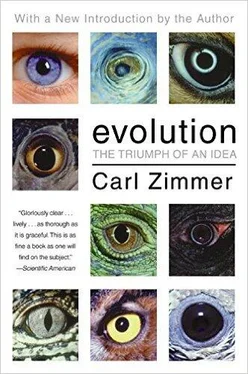The tree is split into three main branches. Our own, the eukaryotes, includes plants, fungi, and animals, as well as single-celled protozoa, such as amoebae that live in the forest soil and the oceans, and parasites that cause diseases like malaria, dysentery, and giardia. Eukaryotes all have a distinct sort of cell. They keep most of their DNA balled up in their nucleus, and their cells contain many other compartments where new proteins are built and energy is generated.
Biologists once thought that all of the species that were not eukaryotes fell into a single group, known as prokaryotes. After all, they all seem to look the same. Their DNA, for instance, floats loose inside their membranes, not coiled in a nucleus. But the genes tell another story. Bacteria form their own branch, while there is a third major branch on the tree of life that is more closely related to us than to bacteria. First identified in the 1970s by University of Illinois biologist Carl Woese, these organisms may look like bacteria, but they have cellular machinery that is radically different. Woese named these microbes archaea, meaning “first,” for the branch on which they appear.
Another great surprise of the new tree of life is just what a small space we multicellular eukaryotes take up in the story of evolution. It’s almost impossible to make out the difference between ourselves and the elm trees. And meanwhile the diversity within the bacteria, archaea, and single-celled eukaryotes turns out to be stunning. Microbiologists are continually dredging up new species, new families, even new kingdoms of microbes, which have colonized the deepest reaches of Earth’s crust, the boiling water of hot springs, and the acid-drenched warmth of the human gut. Most of the diversity of life, not to mention the sheer physical mass, is microbial.
The base of the tree of life represents the last common ancestor of all life on Earth today. All living species share certain things in common. All of them, for example, carry their genetic information as DNA and use RNA to turn them into proteins. The simplest explanation for these universal properties is that all living species inherited them from a common ancestor. That common ancestor therefore must have been a relatively sophisticated creature. In turn, it must have descended from a long line of ancestors. For all we know, there were deeper branches that we can’t see now because they’ve become extinct. And beyond these vanished ancestors lies the origin of life itself.
In Search of Life’s Origins
Even if the tree of life doesn’t reach back to life’s beginning, it can help scientists who are trying to reconstruct that first great biological transformation: from nonlife to life. Along with the geological record, it can offer clues and constraints. Any explanation of how life began has to account for the evidence that has been left behind.
Although scientists are a long way from knowing the precise history of life’s early evolution, they can study it in the same way they study later transitions. As we’ll see in chapter 6, new groups of animals didn’t emerge in one giant leap; rather, pieces of their new body plan were added on step by step until the forms we see in living animals took shape. Scientists have found compelling evidence that life could have evolved into a DNA-based microbe in a series of steps as well.
The first step in the rise of life was to gather its raw materials together. Many of them could have come from space. Astronomers have discovered a number of basic ingredients of life on meteorites, comets, and interplanetary dust. As these objects fell to the early Earth, they could have seeded the planet with components for crucial parts of the cell, such as the phosphate backbone of DNA, its information-bearing bases, and amino acids for making proteins.
As these compounds reacted with one another, they may have produced more lifelike forms. Chemical reactions work best when the molecules involved are crowded together so they bump into one another more often; on the early Earth, the precursors to biological matter might have been concentrated in raindrops or the spray of ocean waves. Some scientists suspect that life began at the midocean ridges where hot magma emerges from the mantle. The branches nearest the base of the tree of life, they point out, belong to bacteria and archaea that live in extreme conditions such as boiling waters or acids. They may be relics of the earliest ecosystems on the planet.
Scientists suspect that prebiological molecules became organized into cycles of chemical reactions that could sustain themselves independently. A group of molecules would fashion more copies of itself by grabbing other molecules that surrounded it. There may have been many separate chemical cycles at work on the early Earth. If they used the same building blocks to complete their cycles, they would have competed with one another. The most efficient cycle would have outstripped the less efficient ones. Before biological evolution, in other words, there was chemical evolution.
Ultimately, these molecules gave rise to DNA, RNA, and proteins. Scientists have debated for decades which of the three emerged first. DNA can carry information for building bodies from one generation to the next, but it is helpless without the help of RNA and proteins. It cannot, for example, join molecules together or cleave them the way enzymes do. Proteins have the opposite shortcoming: they do the work that’s required to keep a cell alive, but it is very difficult for them to carry information from one generation to another. Only RNA can play both roles, carrying a genetic code and doing biochemical work. The twin abilities of RNA make it the leading candidate for life’s first molecule.
When scientists first uncovered RNA’s role in the cell in the 1960s, few thought it might have been the primordial stuff of life. Delivering information from the genes to the protein-building factories of the cell, it seemed like a lowly messenger. But in 1982 Thomas Cech, then at the University of Colorado, discovered that RNA is actually something of a molecular hybrid. On the one hand, it can carry information in its code. On the other hand, Cech found that it can also act as an enzyme, able to alter other molecules. One of the jobs that enzymes do, for example, is to edit out useless sequences after DNA is copied into RNA. Cech discovered that some versions of RNA can loop back on themselves and edit their own code, with no help from enzymes.
In the late 1980s biologists realized that thanks to RNA’s two-faced versatility they could make it evolve in their labs. One of the most successful teams was led by biologist Gerald Joyce, who works at the Scripps Research Institute in La Jolla, California. Joyce began with Cech’s original RNA molecule and replicated it into 10 trillion variations, each with a slightly different structure. He then dumped DNA into the test tubes that held these variants and waited to see whether any of them could cut off a piece of it. Because Cech’s RNA was adapted for cutting RNA, not DNA, it wasn’t a big surprise that none of the RNA variants did a good job. In fact, only one in a million of them managed to grab DNA and slice it. And these few successful molecules were so bad at the job that they needed an hour to do it.
Joyce saved these clumsy RNA molecules and replicated each of them into a million new copies. Once again, the new generation was rife with mutations, and some of the new variants were able to cut DNA faster than the previous generation. Joyce saved these slightly superior RNA molecules and replicated them again. After he had carried out the entire process for 27 generations (a process that took two years), the evolved RNA could cut DNA in only five minutes. In fact, their ability to cut DNA was equal to their natural ability to cut RNA.
Читать дальше












